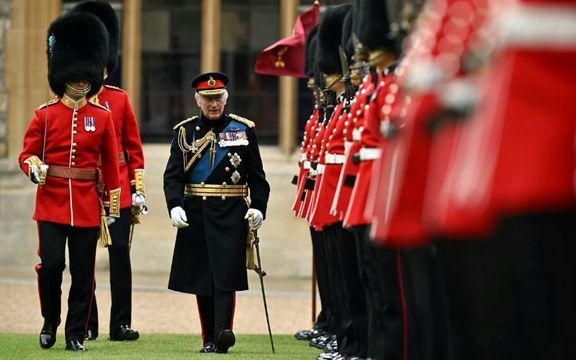
Britain's King Charles III (C) reviews the Irish Guards during a ceremony where he presents New Colours to No 9 and No 12 Company The Irish Guards at Windsor Castle on June 10, 2024 in Windsor.Getty
As the Princess of Wales continues her treatment for cancer, the King who also recently underwent treatment took up the task of presenting the Irish Guards with new colours.
King Charles III presented the Irish Guards with new colors ahead of the Trooping of the Colours on Saturday. Princes Kate, who became Colonel of the Irish Guards in 2022 issued an apology ahead of the presentation that she would not be able to attend as she continues her preventative chemotherapy treatment following a cancer diagnosis.
In her letter apologizing for her absence Colonel Kate, the Princess of Wales, said it was a "great honor" to be the Irish Guard's ceremonial leader and hoped to return to her duties soon.
She wrote “I wanted to write and let you know how proud I am of the entire Regiment ahead of the Colonel’s Review and Trooping the Colour.
"I appreciate everyone trooping this year has been practicing for months, and dedicating many hours to ensuring their uniforms and drills are immaculate.
"Being your Colonel remains a great honor, and I am very sorry that I’m unable to take the salute at this year’s Colonel’s Review."

Prince William and Princess Kate photograhed on St. Patrick's Day prior to her cancer diagnosis.
The Trooping of the Colours, which will take place next Saturday, is a traditional ceremony held to celebrate the official birthday of the British monarch. This event has been conducted for over 260 years and is a significant display of British military pageantry.
The parade features over 1,400 parading soldiers, 200 horses, and 400 musicians from 10 bands. The Household Division, which includes regiments like the Grenadier Guards, Coldstream Guards, Scots Guards, Irish Guards, and Welsh Guards, is prominently involved.
King Charles, who was also recently diagnosed with a form of cancer, had initially stepped back from public duties. It was confirmed last month that he will take part in the Trooping of the Colours, however it is understood that his participation will be called back. He will sit in a horse-drawn carriage beside Queen Camilla, as opposed to riding on horseback.
It has not yet been confirmed whether Kate will make an appearance. Last week, a Kensington Palace spokesman said: "The princess is not expected to return to work until it's cleared by her medical team."
Who are the Irish Guard
The Irish Guards are an infantry regiment of the British Army, part of the Guards Division, known for their distinctive St. Patrick's blue plume in their bearskin hats. The Irish Guards were formed by order of Queen Victoria on 1 April 1900 to commemorate the Irishmen who fought in the Second Boer War for the British Empire.

The Irish Guard.
Historically, the regiment was closely associated with Ireland, and its ranks were originally filled by Irishmen. However, this connection has evolved over time.
Post-1922: After the partition of Ireland in 1922 and the creation of the Irish Free State (now the Republic of Ireland), the direct association with Ireland diminished.
Recruitment: The Irish Guards recruit from all parts of the United Kingdom and the Commonwealth, and they no longer have a special recruitment relationship with the Republic of Ireland.
Despite the changes, the regiment maintains Irish traditions, such as wearing the shamrock on St. Patrick's Day, and many of its members still have Irish heritage.
During World War I, the Irish Guards served on the Western Front, earning numerous battle honors. During WWII they fought in key campaigns, including the Norwegian Campaign, the North African Campaign, and the D-Day landings in Normandy.
Since the World War, the regiment continued to serve in various roles and locations, including Northern Ireland during the Troubles, and more recently in Afghanistan and Iraq as part of the global War on Terror.
The Irish Guards are one of the five regiments of Foot Guards, performing both ceremonial and operational roles. They are known for their participation in high-profile public duties such as the Changing of the Guard at Buckingham Palace and Trooping the Colour.





Comments